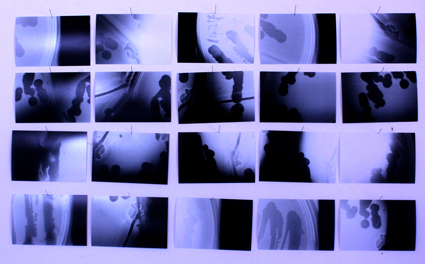New degree in Neo-life
SymbioticA, Master of Biological Arts, UWA

Unsettling eros of contact zones, Tarsh Bates
Here’s exciting news for experienced art practitioners, scientists, or humanities scholars who wish to engage with creative bioresearch. SymbioticA, a world-renowned Artistic Research Laboratory embedded within the School of Anatomy, Physiology and Human Biology at The University of Western Australia, is offering a Master of Biological Arts degree.
Academic coordinator and Assistant Professor Ionat Zurr writes, “The Master of Biological Arts (aka the Alternative MBA) is offered to those who are interested in what is happening with (and to) life today. Students have access to recent technology and expertise in the field of science (particularly the life sciences) and are required to explore them, hands on, in a cultural and artistic context. We encourage critical thinking, ethical provocations, controversial future scenarios, and questioning of current practices and politics, all through a rigorous and informed engagement with the fields of art and the sciences.”
In the first of the two years of the course, students with arts backgrounds will take relevant science units, while students from the sciences will take units in fine arts and/or performance, literature etc. The focus in the second year is “the student’s own creative research with access to scientific laboratories and mentorship from the arts and the sciences,” in the context of SymbioticA’s other activities involving “core and visiting researchers from around the world.”
Previous student projects include the deploying of “living neural tissues as agents for digital corruption and misinformation”; conducting experimental portraiture in the making of death masks for laboratory disease model mice; drawing imaginary landscapes using sleep science techniques with living, sleeping bodies; exploring “interspecies relations and feminist critique by caring and living with slime molds”; and converting “an atomic force microscope into a musical instrument that plays by touching living cells.”
The accompanying image is from the work of Tarsh Bates who completed a Master of Science (Biological Arts) in 2012 and is currently a candidate for a PhD (Biological Arts) at SymbioticA where “her research is concerned with gentleness, the aesthetics of interspecies relationships and the human as a multispecies ecology. She is particularly enamoured with Candida Albicans, the single-celled opportunistic fungal pathogen commonly known as thrush.” RT
For information: http://www.symbiotica.uwa.edu.au; sym@symbiotica.uwa.edu.au
RealTime issue #122 Aug-Sept 2014 pg. 22






